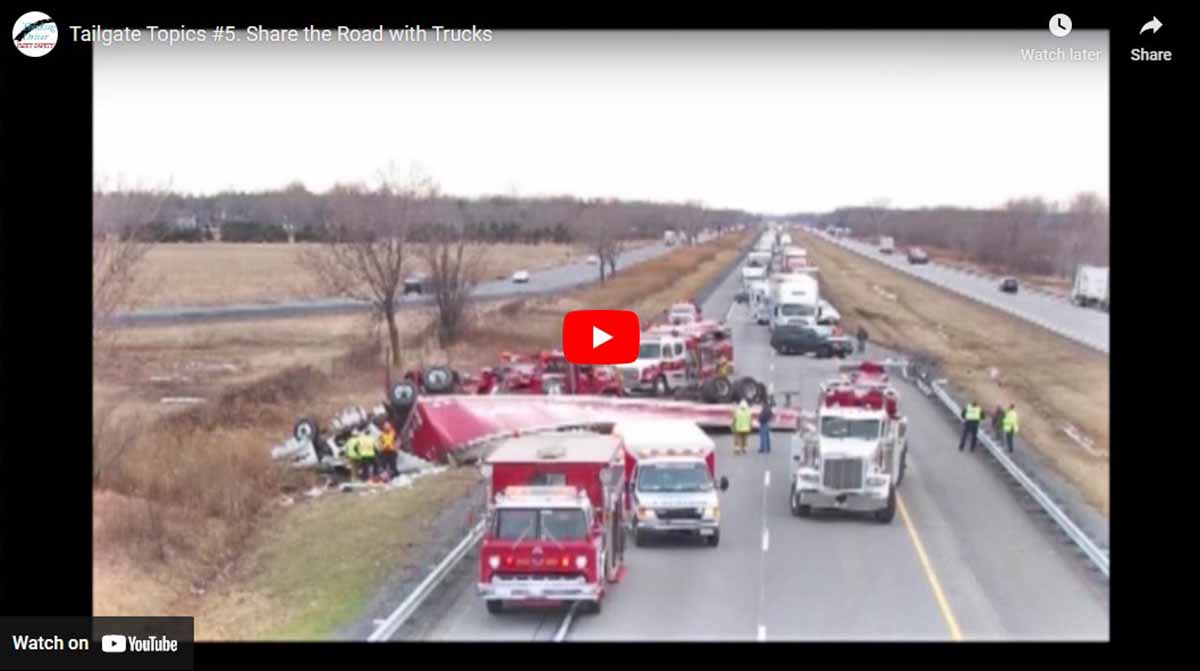Safety Meeting Planner & Agenda
Share the Road Safely With Trucks!
Meeting Leader:
- Prepare in advance to make this meeting effective.
- Print and read over this entire agenda.
- Think about how you want to lead the meeting.
- Is there anything that is specific to your company or operation that you can include to personalize the information?
- Review the video for this session.
- Save the link to the video in your ‘Favourites’ folder on your browser for easy access.
- Open and then minimize the viewer just before the meeting to make the video introduction smooth.
Meeting Leader’s Guide:
Opening Statement:
On every highway in our nation, we find a mixture of vehicles: everything from the smallest – motorcycles, bicycles and scooters; to the very largest – heavy trucks often weighing 80,000 lbs or over 36,000 kgs. That’s 40 times the weight of a typical passenger vehicle.
In the US, 5,000 people, every year died in large truck crashes, with nearly 4,000 of those being the result of passenger vehicles and trucks colliding. In Canada, it’s a similar number per capita.
Questions for this Meeting:
Q: When there is a fatal crash between a large truck and a passenger vehicle or smaller vehicle, which driver is typically the one who made the mistake that resulted in the crash?
Leader: Discuss and encourage debate; ask why do you think that?
Answer:
Surprising to many people, in fatal crashes involving large trucks with passenger vehicles, the large truck driver’s actions are a factor in only 22% of the crashes, while in over 80% of accidents, the passenger vehicle drivers were the main factor.
Q: What driver actions, on the part of the smaller vehicle may have contributed to a crash? What are the common mistakes that drivers make around larger vehicles?
Answer:
- Driving in the blind spot or ‘No-Zone’ of the large truck where the larger vehicle can’t see the smaller one,
- Passing a truck and cutting in too closely in front of it,
- Tailgating the truck,
- Driving too close to the truck on either side, in another lane, and not keeping your options open. This also takes away the room for the truck to maneuver.
Tailgate Tips for Staying Safe Around Large Vehicles:
Truck drivers have a difficult job navigating through traffic to make their deliveries on time and this task can be made much more difficult if we don’t share the road in a safe and responsible manner.
A fully loaded semi takes a much greater distance to stop and is much less maneuverable than a smaller vehicle so we need to take special care to give them the room that they need to keep everyone safe.
- Stay Out of the ‘No-Zone’. ‘No-Zones’ are blind spots where you ‘disappear’ from the view of the truck driver. Make sure that you can see the truck’s mirrors. If you can’t see the mirror, the truck driver can’t see you. So stay visible!
- Leave a Good Gap When Lane Changing in front of a truck. Large trucks need a much longer braking distance than cars. Don’t cut into a truck’s space; if this happens it reduces a truck’s much needed braking distance and restricts evasive action. At least a 4 second gap is best.
- Don’t Tailgate a Truck. The further you are away from a truck the less likely you will be involved in a collision and the better your vision around the truck will be. Stay well back. This increases your vision and lets you prepare for what’s coming up in front of the truck.
- Allow Plenty of Room. Large trucks are almost as wide as your lane of travel. Following too closely behind one or driving in the next lane unnecessarily beside one reduces the space needed for you and the truck driver to react to changing traffic conditions and patterns. Keep your options open by maintaining your space cushion!
- Buckle Up! In case you are involved in a crash with a truck or any other vehicle, wearing your seatbelt is the single most important thing you can do to save your life in a crash.
What About Unsafe Truck Drivers?
What is the best response when you see a truck driver driving aggressively?
If you see a truck driver driving aggressively and trying to cut through traffic, this unsafe driving may irritate or even provoke you to consider some sort of retaliation. A better option is to note the name on the truck, the license plate number, time and location. Call the trucking company and report the driver. The company will be very interested in this information and the effect on the driver will be much more effective.
Summary:
- Stay out of the ‘No-Zone’.
- Leave a good gap.
- Don’t tailgate.
- Allow plenty of room.
- Wear your seat belt.
Practical Challenge:
This week, pay special attention to heavy trucks when you are driving, and work to keep your space while giving the truck driver the room he needs to stay out of trouble!









